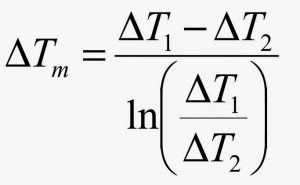Derive Overall material balance equation for heat exchanger and explain importance of LMTD.
Derive Overall material balance equation for heat exchanger and explain importance of LMTD.
Material balance equation for heat exchanger
Energy balance calculation is often done for designing a heat exchanger to determine operating parameters for hot and cold fluids such as - inlet / outlet temperatures and flow rates.
For hot fluid side of a heat exchanger let,
mH : mass flow rate of the hot fluid in kg/hr
CpH : mass heat capacity of the hot fluid in Joules/kg0C
TiH and ToH : Respectively inlet and outlet temperatures on exchanger hot side in 0C
mC : mass flow rate of the cold fluid in kg/hr
CpC : mass heat capacity of the cold fluid in Joules/kg0C
TiC and ToC : Respectively inlet and outlet temperatures on exchanger cold side in 0C
Heat lost by the hot fluid = -Q = mH × CpH × (ToH - TiH) … (1)
Heat gained by the cold side = Q = mC × CpC × (ToC - TiC) … (2)
Comparing equations (1) and (2),
mH × CpH × (TiH - ToH) = mC × CpC × (ToC - TiC) … (3) (Heat balance equation)
This energy (heat) balance equation can be solved for one variable for any given case. Out of total six variables in the equation (3), five should be fixed to determine the unknown variable.
It should also be noted that the mass balance equation is already applied in this case to develop equation (3).
The fact that mHin = mHout = mH and mCin = mCout = mC is already considered while writing equations (1) and (2). Hence application of mass balance equation for heat exchanger does not present any new information here.
LMTD
Importance of LMTD.
LMTD is the logarithmic mean of temperature difference of the fluids at both the sides of the heat exchangers.
LMTD is introduced due to the fact, the temperature change that takes place across the heat exchanger from the entrance to the exit is not linear.
LMTD is the driven force for the heat exchange between the two fluids. As the LMTD value increases, the amounts of heat transfer between the two fluids also increase. The LMTD value is used for calculating the heat duty of the heat exchanger. The formula is:
Assumptions made in LMTD method:
The overall heat transfer coefficient (U) is constant throughout the heat energy.
The specific heats (Cp) and mass flow rates of both fluids is constant.
The flow conditions are steady.
There is no change of phase either of the fluid during the heat transfer.
There is no loss of heat to the surroundings, due to heat exchanger being perfectly insulated.
Axial conduction along the tubes of heat exchanger is negligible.
The changes in kinetic energy and potential energy are negligible.

Comments
Post a Comment